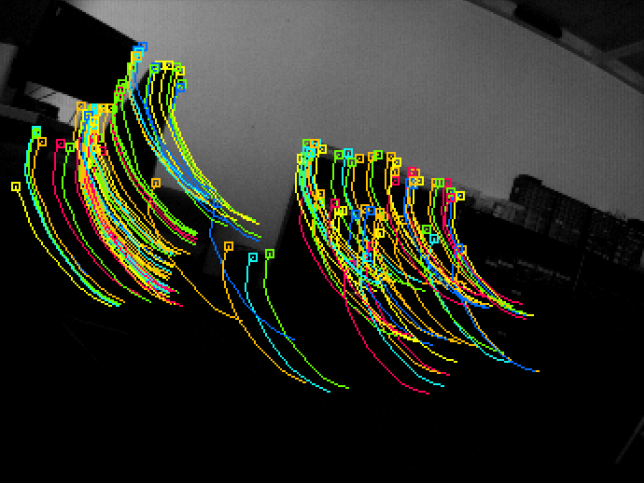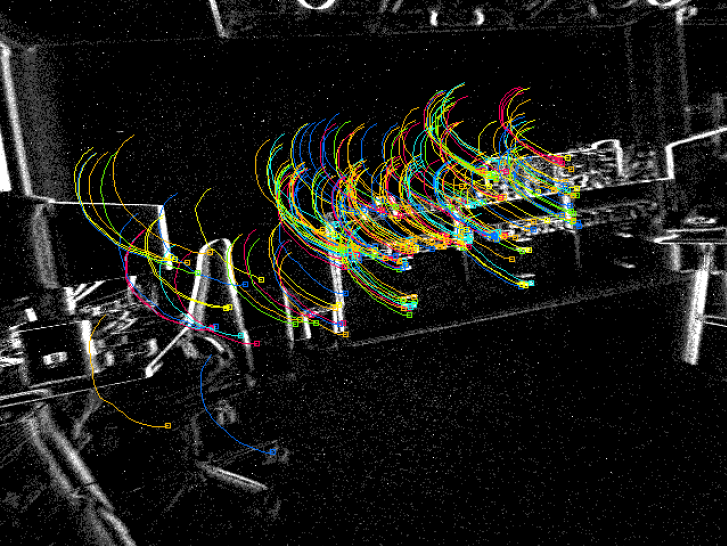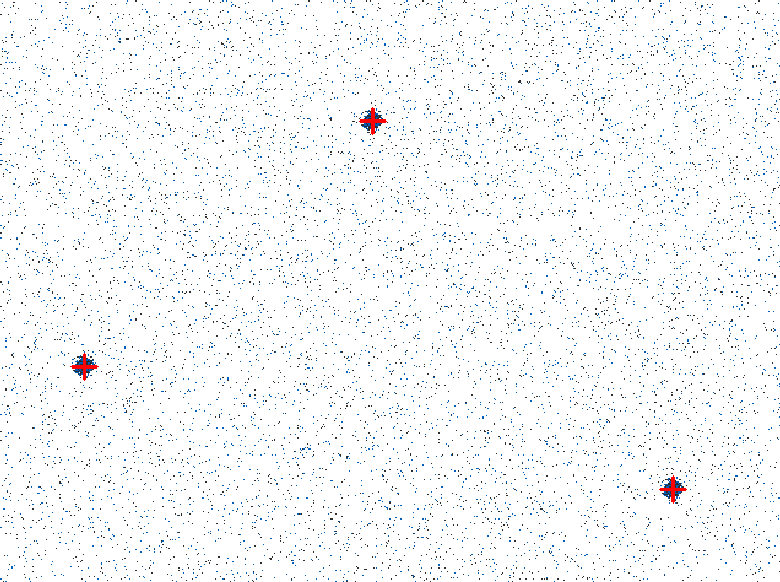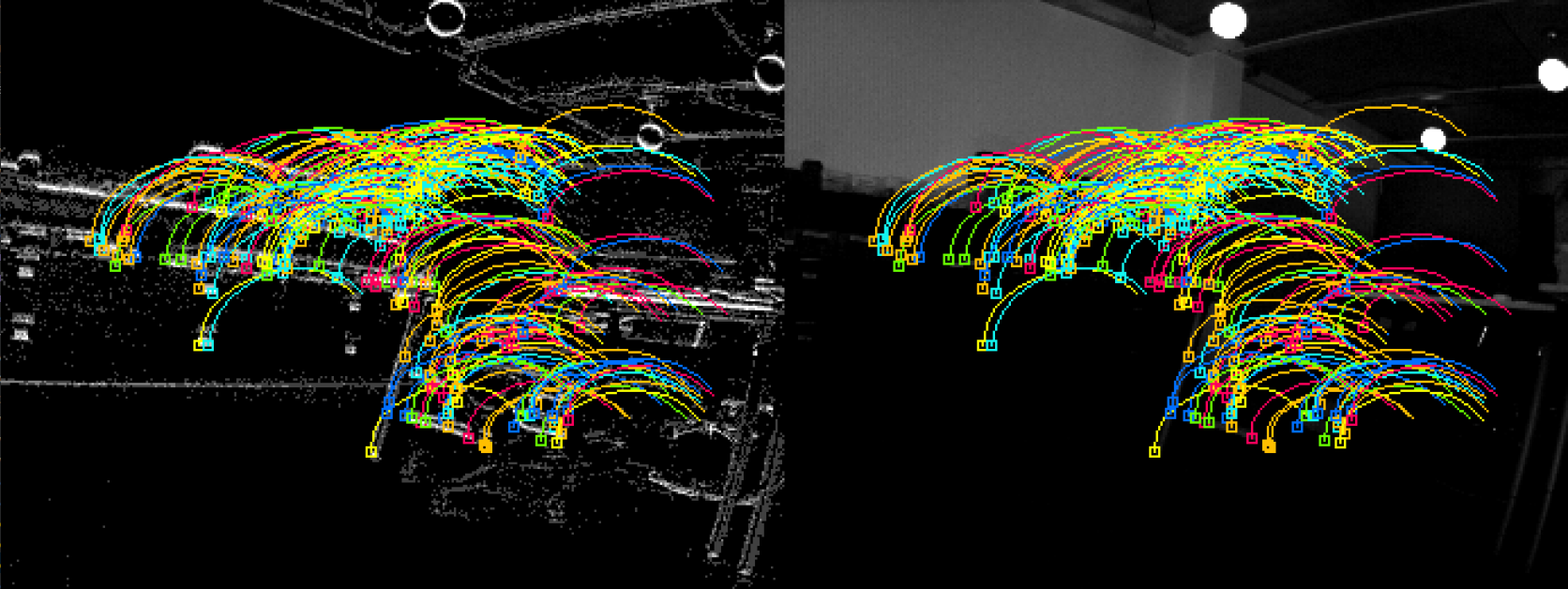Feature tracking
The dv-processing library provides a few algorithm implementations to perform visual tracking of detected features. Feature tracking was intended for use in the frontends of visual odometry pipelines. While tracking on event input is feasible, the library also provides frame-based and hybrid (which uses both events and frames) trackers that allow to build visual odometry pipelines that leverage both input modalities.
Frame-based tracking
Frame based feature tracking is performed by using Lucas-Kanade tracking algorithm. The following sample shows how to use the available frame based tracker with a stream of incoming frames.
The following code sample shows how to run a feature tracker on frames coming from a live camera.
Note
This sample requires a camera that is capable of producing frames, e.g. a DAVIS series camera.
1#include <dv-processing/features/feature_tracks.hpp>
2#include <dv-processing/features/image_feature_lk_tracker.hpp>
3#include <dv-processing/io/camera_capture.hpp>
4
5#include <opencv2/highgui.hpp>
6
7int main() {
8 // Open any camera
9 dv::io::CameraCapture capture;
10
11 // Make sure it supports event stream output, throw an error otherwise
12 if (!capture.isFrameStreamAvailable()) {
13 throw dv::exceptions::RuntimeError("Input camera does not provide a frame stream.");
14 }
15
16 const cv::Size resolution = capture.getFrameResolution().value();
17
18 // Initialize a preview window
19 cv::namedWindow("Preview", cv::WINDOW_NORMAL);
20
21 // Instantiate a visual tracker with known resolution, all parameters kept default
22 auto tracker = dv::features::ImageFeatureLKTracker::RegularTracker(resolution);
23
24 // Create a track container instance that is used to visualize tracks on an image
25 dv::features::FeatureTracks tracks;
26
27 // Run the frame processing while the camera is connected
28 while (capture.isRunning()) {
29 // Try to receive a frame, check if anything was received
30 if (const auto frame = capture.getNextFrame()) {
31 // Pass the frame to the tracker
32 tracker->accept(*frame);
33
34 // Run tracking
35 const auto result = tracker->runTracking();
36
37 // Pass tracking result into the track container which aggregates track history
38 tracks.accept(result);
39
40 // Generate and show a preview of recent tracking history
41 cv::imshow("Preview", tracks.visualize(frame->image));
42 }
43 cv::waitKey(2);
44 }
45
46 return 0;
47}
1import dv_processing as dv
2import cv2 as cv
3
4# Open any camera
5capture = dv.io.CameraCapture()
6
7# Make sure it supports event stream output, throw an error otherwise
8if not capture.isFrameStreamAvailable():
9 raise RuntimeError("Input camera does not provide a frame stream.")
10
11# Initialize preview window
12cv.namedWindow("Preview", cv.WINDOW_NORMAL)
13
14# Instantiate a visual tracker with known resolution, all parameters kept default
15tracker = dv.features.ImageFeatureLKTracker.RegularTracker(capture.getEventResolution())
16
17# Create a track container instance that is used to visualize tracks on an image
18tracks = dv.features.FeatureTracks()
19
20# Run the frame processing while the camera is connected
21while capture.isRunning():
22 # Try to receive a frame
23 frame = capture.getNextFrame()
24
25 # Check if anything was received
26 if frame is not None:
27 # Pass the frame to the tracker
28 tracker.accept(frame)
29
30 # Run tracking
31 result = tracker.runTracking()
32
33 # Pass tracking result into the track container which aggregates track history
34 tracks.accept(result)
35
36 # Generate and show a preview of recent tracking history
37 cv.imshow("Preview", tracks.visualize(frame.image))
38
39 cv.waitKey(2)

Tracked features on a live frame from a camera.
Event-based tracking
Event-based Lucas Kanade tracker
Features can be detected and tracked on a stream of events. The dv::features::EventFeatureLKTracker can
perform this, it accumulates a frame from events internally, runs feature detection and performs Lucas-Kanade tracking
on the accumulated frames.
The following sample code shows how to use the event-only Lucas-Kanade tracker on event stream coming from a live camera.
1#include <dv-processing/features/event_feature_lk_tracker.hpp>
2#include <dv-processing/features/feature_tracks.hpp>
3#include <dv-processing/io/camera_capture.hpp>
4
5#include <opencv2/highgui.hpp>
6
7int main() {
8 // Open any camera
9 dv::io::CameraCapture capture;
10
11 // Make sure it supports event stream output, throw an error otherwise
12 if (!capture.isEventStreamAvailable()) {
13 throw dv::exceptions::RuntimeError("Input camera does not provide an event stream.");
14 }
15
16 const cv::Size resolution = capture.getEventResolution().value();
17
18 // Initialize a preview window
19 cv::namedWindow("Preview", cv::WINDOW_NORMAL);
20
21 // Instantiate a visual tracker with known resolution, all parameters kept default
22 auto tracker = dv::features::EventFeatureLKTracker<>::RegularTracker(resolution);
23
24 // Run tracking by accumulating frames with 100 FPS
25 tracker->setFramerate(100);
26
27 // Create a track container instance that is used to visualize tracks on an image
28 dv::features::FeatureTracks tracks;
29
30 // Run the frame processing while the camera is connected
31 while (capture.isRunning()) {
32 // Try to receive a batch of events, check if anything was received
33 if (const auto events = capture.getNextEventBatch()) {
34 // Pass the frame to the tracker
35 tracker->accept(*events);
36
37 // Run tracking
38 const auto result = tracker->runTracking();
39
40 // Since we are passing events in fine-grained batches, tracking will not execute
41 // until enough events is received, returning invalid pointer if tracking did not execute
42 if (!result) {
43 continue;
44 }
45
46 // Pass tracking result into the track container which aggregates track history
47 tracks.accept(result);
48
49 // Generate and show a preview of recent tracking history
50 cv::imshow("Preview", tracks.visualize(tracker->getAccumulatedFrame()));
51 }
52 cv::waitKey(2);
53 }
54
55 return 0;
56}
1import dv_processing as dv
2import cv2 as cv
3
4# Open any camera
5capture = dv.io.CameraCapture()
6
7# Make sure it supports event stream output, throw an error otherwise
8if not capture.isEventStreamAvailable():
9 raise RuntimeError("Input camera does not provide an event stream.")
10
11# Initialize preview window
12cv.namedWindow("Preview", cv.WINDOW_NORMAL)
13
14# Instantiate a visual tracker with known resolution, all parameters kept default
15tracker = dv.features.EventFeatureLKTracker.RegularTracker(capture.getEventResolution())
16
17# Run tracking by accumulating frames with 100 FPS
18tracker.setFramerate(100)
19
20# Create a track container instance that is used to visualize tracks on an image
21tracks = dv.features.FeatureTracks()
22
23# Run the frame processing while the camera is connected
24while capture.isRunning():
25 # Try to receive a batch of events
26 events = capture.getNextEventBatch()
27
28 # Check if anything was received
29 if events is not None:
30 # Pass the events to the tracker
31 tracker.accept(events)
32
33 # Run tracking
34 result = tracker.runTracking()
35
36 # Since we are passing events in fine-grained batches, tracking will not execute
37 # until enough events is received, returning a `None` if tracking did not execute
38 if result is None:
39 continue
40
41 # Pass tracking result into the track container which aggregates track history
42 tracks.accept(result)
43
44 # Generate and show a preview of recent tracking history
45 cv.imshow("Preview", tracks.visualize(tracker.getAccumulatedFrame()))
46
47 cv.waitKey(2)

Tracked features on a stream of events from a camera.
Event-based mean shift tracker
Detect and track features on a stream of events using mean shift algorithm. Although commonly used for clustering, the
dv::features::MeanShiftTracker class provides a tracking implementation on event data based on mean shift
update. The class internally detects interesting features to track from events (by default it uses
dv::features::EventBlobDetector) and tracks them by running a mean shift update on a normalized time
surface of events. The tracking is performed by following the interesting points detected on the time surface. The
algorithm will shift the tracks towards the latest events, since it takes into account the intensity of the time surface
when performing the track location update.
The algorithm can be summarized as follows:
Given a set of events, detect interesting blobs using
dv::features::EventBlobDetector. (Note, this step happens if no track has been initialized or if redetection is enabled)Compute the time surface representation of a given interval duration.
Given a set of input track locations, for each non-converged track retrieve the time surface of events within a configured window.
Calculate the mean of coordinates for the retrieved neighborhood, weighting each coordinate by the time surface intensity value.
Shift the initial track location by a mode, which is a vector going from the initial point to the mean coordinate multiplied by a learning rate factor.
If the mode of a vector is lower than a configured threshold, the track is considered to have converged into the new position, otherwise repeat from step one.
This algorithm is useful to track event blobs that could be used as point of interest in event processing algorithms.
The following code sample shows the use of our mean-shift tracker implementation to find and track events on sample data generated synthetically.
1#include <dv-processing/core/event.hpp>
2#include <dv-processing/data/generate.hpp>
3#include <dv-processing/features/mean_shift_tracker.hpp>
4#include <dv-processing/visualization/events_visualizer.hpp>
5
6#include <opencv2/highgui.hpp>
7#include <opencv2/imgproc.hpp>
8
9[[nodiscard]] dv::EventStore generateEventClustersAtTime(const int64_t time, const std::vector<dv::Point2f> &clusters,
10 const uint64_t numIter, const cv::Size &resolution, const int shift = -5);
11
12int main() {
13 using namespace std::chrono_literals;
14
15 // Use VGA resolution
16 const cv::Size resolution(640, 480);
17
18 // Initialize a slicer
19 dv::EventStreamSlicer slicer;
20
21 // Initialize a preview window
22 cv::namedWindow("Preview", cv::WINDOW_NORMAL);
23
24 // Initialize a list of clusters for synthetic data generation
25 const std::vector<dv::Point2f> clusters(
26 {dv::Point2f(550.f, 400.f), dv::Point2f(70.f, 300.f), dv::Point2f(305.f, 100.f)});
27
28 // Generate some random events for a background
29 dv::EventStore events = dv::data::generate::uniformlyDistributedEvents(0, resolution, 10'000);
30
31 std::vector<int64_t> timestamps = {0, 40000, 80000, 120000, 160000, 200000, 240000, 280000, 320000, 360000};
32
33 uint64_t numIter = 0;
34 for (const auto time : timestamps) {
35 auto eventCluster = generateEventClustersAtTime(time, clusters, numIter, resolution);
36 events += eventCluster;
37 events += dv::data::generate::uniformlyDistributedEvents(time, resolution, 10000, numIter);
38 numIter++;
39 }
40
41 // Bandwidth value defining the size of the search window in which updated track location will be searched
42 const int bandwidth = 10;
43
44 // Time window used for the normalized time surface computation. In this case we take the last 50ms of events and
45 // compute a normalized time surface over them
46 const dv::Duration timeWindow = 50ms;
47
48 // Initialize a mean shift tracker.
49 dv::features::MeanShiftTracker meanShift = dv::features::MeanShiftTracker(resolution, bandwidth, timeWindow);
50
51 dv::visualization::EventVisualizer visualizer(resolution);
52
53 // Register a callback every 40 milliseconds
54 slicer.doEveryTimeInterval(40ms, [&](const dv::EventStore &events) {
55 meanShift.accept(events);
56 auto meanShiftTracks = meanShift.runTracking();
57
58 if (!meanShiftTracks) {
59 return;
60 }
61
62 // visualize mean shift tracks
63 auto preview = visualizer.generateImage(events);
64 auto points = dv::data::fromTimedKeyPoints(meanShiftTracks->keypoints);
65 cv::drawKeypoints(preview, points, preview, dv::visualization::colors::red);
66
67 cv::imshow("Preview", preview);
68 cv::waitKey(300);
69 });
70
71 slicer.accept(events);
72
73 return EXIT_SUCCESS;
74}
75
76dv::EventStore generateEventClustersAtTime(const int64_t time, const std::vector<dv::Point2f> &clusters,
77 const uint64_t numIter, const cv::Size &resolution, const int shift) {
78 // Declare a region filter which we will use to filter out-of-bounds events in the next step
79 dv::EventRegionFilter filter(cv::Rect(0, 0, resolution.width, resolution.height));
80 const float offset = static_cast<float>(shift * static_cast<int>(numIter));
81 dv::EventStore eventFiltered;
82 for (const auto &cluster : clusters) {
83 const auto xShift = cluster.x() + offset;
84 const auto yShift = cluster.y() + offset;
85 const dv::Point2f point = dv::Point2f(xShift, yShift);
86 // Generate a batch of normally distributed events around each of the cluster centers
87 filter.accept(dv::data::generate::normallyDistributedEvents(time, point, dv::Point2f(3.f, 3.f), 1'000));
88
89 // Apply region filter to the events to filter out events outside valid dimensions
90 eventFiltered += filter.generateEvents();
91 }
92
93 return eventFiltered;
94}
1import datetime
2
3import dv_processing as dv
4import cv2 as cv
5
6
7def generate_event_clusters_at_time(time, clusters, num_iter, shift=-5):
8 # Declare a region filter which we will use to filter out-of-bounds events in the next step
9 event_filter = dv.EventRegionFilter((0, 0, resolution[0], resolution[1]))
10 event_filtered = dv.EventStore()
11 track_id = 0
12 offset = shift * num_iter
13 for cluster in clusters:
14 x_coord = cluster[0] + offset
15 y_coord = cluster[1] + offset
16
17 # Generate a batch of normally distributed events around each of the cluster centers
18 event_filter.accept(dv.data.generate.normallyDistributedEvents(time, (x_coord, y_coord), (3, 3), 1000))
19
20 # Apply region filter to the events to filter out events outside valid dimensions
21 event_filtered.add(event_filter.generateEvents())
22
23 track_id += 1
24
25 return event_filtered
26
27
28def run_mean_shift(events):
29 mean_shift.accept(events)
30 mean_shift_tracks = mean_shift.runTracking()
31
32 preview = visualizer.generateImage(events)
33
34 # Draw markers on each of the track coordinates
35 if len(mean_shift_tracks.keypoints) > 0:
36 for index in range(len(mean_shift_tracks.keypoints)):
37 track = mean_shift_tracks.keypoints[index]
38 cv.drawMarker(preview, (int(track.pt[0]), int(track.pt[1])), dv.visualization.colors.red(), cv.MARKER_CROSS,
39 20, 2)
40
41 # Show the preview image with detected tracks
42 cv.imshow("Preview", preview)
43 cv.waitKey(10)
44
45
46# Use VGA resolution
47resolution = (640, 480)
48
49# Initialize a slicer
50slicer = dv.EventStreamSlicer()
51
52# Initialize a preview window
53cv.namedWindow("Preview", cv.WINDOW_NORMAL)
54
55# Initialize a list of clusters for synthetic data generation
56clusters = [(550, 400), (70, 300), (305, 100)]
57
58# Generate some random events for a background
59events = dv.data.generate.uniformlyDistributedEvents(0, resolution, 10000)
60
61timestamps = [0, 40000, 80000, 120000, 160000, 200000, 240000, 280000, 320000, 360000]
62
63num_iter = 0
64for time in timestamps:
65 event_cluster = generate_event_clusters_at_time(time, clusters, num_iter)
66 events.add(event_cluster)
67 events.add(dv.data.generate.uniformlyDistributedEvents(time, resolution, 10000, num_iter))
68 num_iter += 1
69
70# parameter defining the spatial window [pixels] in which the new track position will be searched
71bandwidth = 10
72
73# window of time used to compute the time surface used for the tracking update
74time_window = datetime.timedelta(milliseconds=50)
75
76# Initialize a mean shift tracker
77mean_shift = dv.features.MeanShiftTracker(resolution, bandwidth, time_window)
78
79visualizer = dv.visualization.EventVisualizer(resolution)
80
81slicer.doEveryTimeInterval(datetime.timedelta(milliseconds=40), run_mean_shift)
82
83slicer.accept(events)

Expected output of the mean-shift-tracker sample usage. Tracking eight blobs marked with red crosses.
Hybrid tracking
The high-framerate tracking on event stream suggests that the feature tracking on frames can be improved by tracking
features between frames on intermediate accumulated frames from events. The intermediate tracking results can be used as
a prior to the frame tracking algorithm. Such an approach is implemented in
dv::features::EventCombinedLKTracker, it performs regular Lucas-Kanade tracking on frames, but also
constructs intermediate accumulated frames to predict the locations of tracks in the next frame and uses this
information as a prior to the Lucas-Kanade tracking algorithm.
The following sample code shows how to use the hybrid event-frame Lucas-Kanade tracker on both streams coming from a live camera.
Note
This sample requires a camera that is capable of producing frames and events, e.g. a DAVIS series camera.
1#include <dv-processing/features/event_combined_lk_tracker.hpp>
2#include <dv-processing/features/feature_tracks.hpp>
3#include <dv-processing/io/camera_capture.hpp>
4
5#include <opencv2/highgui.hpp>
6
7int main() {
8 // Open any camera
9 dv::io::CameraCapture capture;
10
11 // Make sure it supports correct stream outputs, throw an error otherwise
12 if (!capture.isEventStreamAvailable()) {
13 throw dv::exceptions::RuntimeError("Input camera does not provide an event stream.");
14 }
15 if (!capture.isFrameStreamAvailable()) {
16 throw dv::exceptions::RuntimeError("Input camera does not provide a frame stream.");
17 }
18
19 const cv::Size resolution = capture.getEventResolution().value();
20
21 // Initialize a preview window
22 cv::namedWindow("Preview", cv::WINDOW_NORMAL);
23
24 // Instantiate a visual tracker with known resolution, all parameters kept default
25 auto tracker = dv::features::EventCombinedLKTracker<>::RegularTracker(resolution);
26
27 // Accumulate and track on 5 intermediate accumulated frames between each actual frame pair
28 tracker->setNumIntermediateFrames(5);
29
30 // Create a track container instance that is used to visualize tracks on an image
31 dv::features::FeatureTracks tracks;
32
33 // Use a queue to store incoming frames to make sure the all data has arrived prior to running the tracking
34 std::queue<dv::Frame> frameQueue;
35
36 // Run the frame processing while the camera is connected
37 while (capture.isRunning()) {
38 // Try to receive a frame, check if anything was received
39 if (const auto frame = capture.getNextFrame()) {
40 // Push the received frame into the frame queue
41 frameQueue.push(*frame);
42 }
43
44 // Try to receive a batch of events, check if anything was received
45 if (const auto events = capture.getNextEventBatch()) {
46 // Pass the frame to the tracker
47 tracker->accept(*events);
48
49 // Check if we have ready frames and if enough events have arrived already
50 if (frameQueue.empty() || frameQueue.front().timestamp > events->getHighestTime()) {
51 continue;
52 }
53
54 // Take the last frame from the queue
55 const auto frame = frameQueue.front();
56
57 // Pass it to the tracker as well
58 tracker->accept(frame);
59
60 // Remove the last used frame from the queue
61 frameQueue.pop();
62
63 // Run tracking
64 const auto result = tracker->runTracking();
65
66 // Validate that the tracking was successful
67 if (!result) {
68 continue;
69 }
70
71 // Pass tracking result into the track container which aggregates track history
72 tracks.accept(result);
73
74 // Generate and show a preview of recent tracking history on both accumulated frames and the frame image
75 // Take the set of intermediate accumulated frames from the tracker
76 const auto accumulatedFrames = tracker->getAccumulatedFrames();
77 if (!accumulatedFrames.empty()) {
78 cv::Mat preview;
79 // Draw visualization on both image and concatenate them horizontally
80 cv::hconcat(
81 tracks.visualize(accumulatedFrames.back().pyramid.front()), tracks.visualize(frame.image), preview);
82 // Show the final preview image
83 cv::imshow("Preview", preview);
84 }
85 }
86
87 cv::waitKey(2);
88 }
89
90 return 0;
91}
1import dv_processing as dv
2import cv2 as cv
3from datetime import timedelta
4
5# Open any camera
6capture = dv.io.CameraCapture()
7
8# Make sure it supports correct stream outputs, throw an error otherwise
9if not capture.isEventStreamAvailable():
10 raise RuntimeError("Input camera does not provide an event stream.")
11if not capture.isEventStreamAvailable():
12 raise RuntimeError("Input camera does not provide a frame stream.")
13
14# Initialize preview window
15cv.namedWindow("Preview", cv.WINDOW_NORMAL)
16
17# Instantiate a visual tracker with known resolution, all parameters kept default
18tracker = dv.features.EventCombinedLKTracker.RegularTracker(capture.getEventResolution())
19
20# Accumulate and track on 5 intermediate accumulated frames between each actual frame pair
21tracker.setNumIntermediateFrames(5)
22
23# Create a track container instance that is used to visualize tracks on an image
24tracks = dv.features.FeatureTracks()
25
26# Use a list to store incoming frames to make sure the all data has arrived prior to running the tracking
27frame_queue = []
28
29# Run the frame processing while the camera is connected
30while capture.isRunning():
31 # Try to receive a frame
32 frame = capture.getNextFrame()
33
34 # Check if anything was received
35 if frame is not None:
36 frame_queue.append(frame)
37
38 # Try to receive a batch of events
39 events = capture.getNextEventBatch()
40
41 # Check if anything was received
42 if events is not None:
43 # Pass the events to the tracker
44 tracker.accept(events)
45
46 # Check if we have ready frames and if enough events have arrived already
47 if len(frame_queue) == 0 or frame_queue[0].timestamp > events.getHighestTime():
48 continue
49
50 # Take the last frame from the queue and remove it
51 frame = frame_queue.pop(0)
52
53 # Pass it to the tracker as well
54 tracker.accept(frame)
55
56 # Run tracking
57 result = tracker.runTracking()
58
59 # Validate that the tracking was successful
60 if result is None:
61 continue
62
63 # Pass tracking result into the track container which aggregates track history
64 tracks.accept(result)
65
66 # Generate and show a preview of recent tracking history on both accumulated frames and the frame image
67 # Take the set of intermediate accumulated frames from the tracker
68 accumulated_frames = tracker.getAccumulatedFrames()
69 if len(accumulated_frames) > 0:
70 # Draw visualization on both image and concatenate them horizontally
71 preview = cv.hconcat([tracks.visualize(accumulated_frames[-1].pyramid[0]), tracks.visualize(frame.image)])
72
73 # Show the final preview image
74 cv.imshow("Preview", preview)
75
76 cv.waitKey(2)

Tracked features on frame and event streams from a camera.